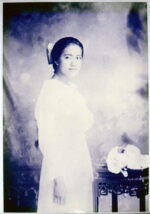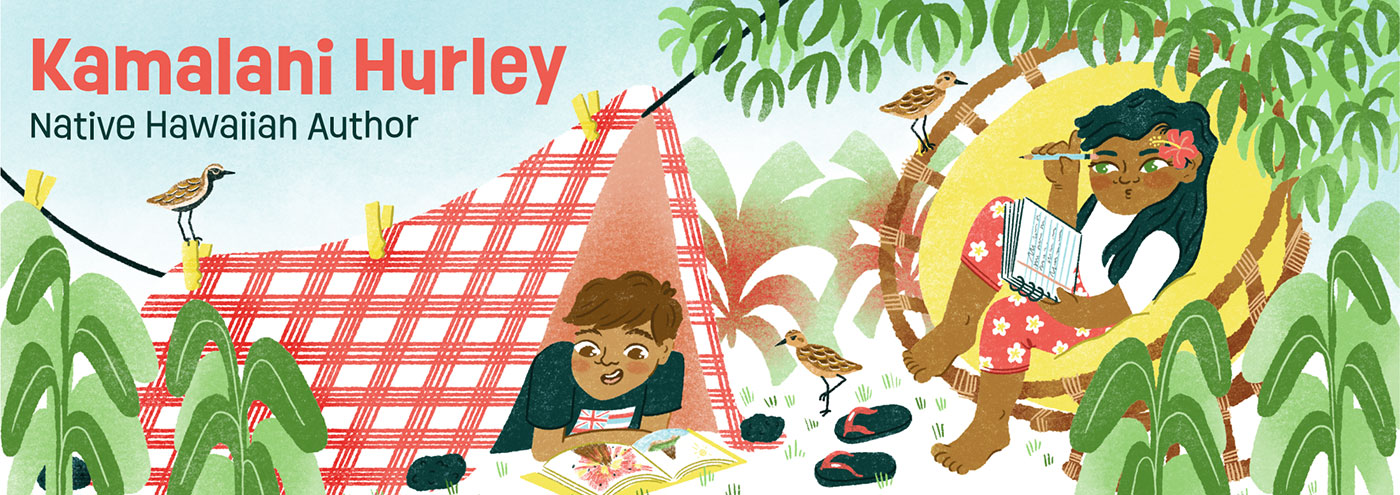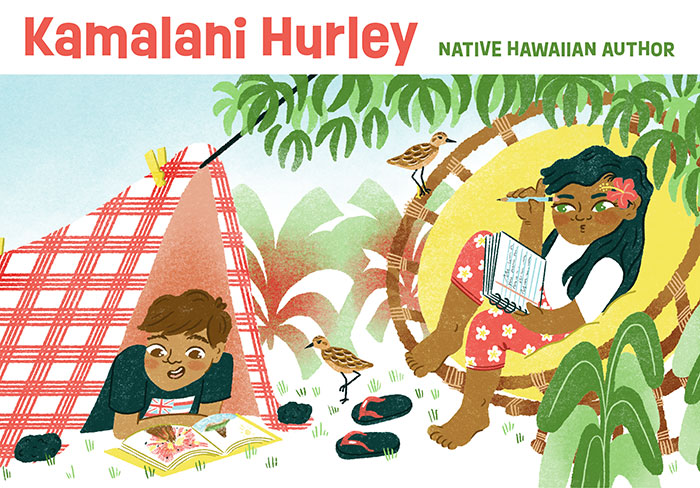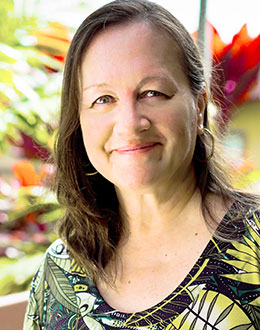
One of the activities Iʻm most proud of is founding and publishing Pūpū A ‘O ‘Ewa Native Hawaiian Writing and Arts. Everyone—students, faculty, staff, and community members—was invited to submit, regardless of ethnicity, and the only requirement was that the work be somehow related to Native Hawaiian culture. From 2011–2016 we published over 100 videos, music, photos, and stories. Those works are archived at Pūpū, but I think my blog is a good place to feature some of them again. The works and their creators deserve to be seen and appreciated.
In her beautiful personal history, Her Name was Violet, first published at Pūpū in 2014, Stephanie Namahoe Launiu describes writing about her grandmother, Violet Wong Hoe, as a spiritual experience: Grandma was born only two years after annexation at a time when Hawaiians weren’t free to speak their native language or openly practice their culture. She was so very Hawaiian to the core. Stephanie and her family live in Hilo. Now retired, she volunteers with nonprofits to help Hawaiian inmates and their families on the Big Island. A freelance writer, Stephanie is writing episodes about Hawai’i for an audio travel app company, “doing my best,” she tells me, “to sensitize visitors to wahi pana and kanaka oiwi.” Mahalo nui, Stephanie.
Her Name was Violet
 Her name was Violet Kawaikoeahiokekuahiwi Wong Hoe, and she was my father’s mother. Born in 1900 to a pure Hawaiian woman and a Chinese laborer who came to work on a sugar plantation, Grandma was the single most influential person in my life. She was my link to being Hawaiian.
Her name was Violet Kawaikoeahiokekuahiwi Wong Hoe, and she was my father’s mother. Born in 1900 to a pure Hawaiian woman and a Chinese laborer who came to work on a sugar plantation, Grandma was the single most influential person in my life. She was my link to being Hawaiian.
Grandma was tough stuff, born just seven years after a group of American businessmen illegally overthrew the Hawaiian monarch, Queen Liliuokalani, and instituted a straw government recognized by the United States of America. At five years old, she cried on a boat dock as her father (who she said looked like Hop Sing on the old Bonanza show) jumped onto a ship to return to China. His contract with the plantation had ended, and he most likely had a wife and children back home. We haven’t had any luck tracing our bloodline to China, so it’s one of those things we just had to let go. She remembered the day when she was nine and some men came to her house and dragged her mother away, kicking and screaming. She never saw her mother again. And as Hawaiians of the day were taught, she never talked about it.
After years of research, we found out last year that our great-grandmother had been dragged away that long-ago day and taken on a boat to Kalaupapa, Molokaʻi, where she was checked into the leper colony for Hawaiian citizens and never allowed away from that isolated spot again. She died there after remarrying and having three more children. We don’t know if she ever had leprosy. In the early 1900’s when the fear of leprosy was rampant, Hawaiians were routinely arrested and taken to Kalaupapa for the rest of their lives on a whispered suspicion that the spot on their face was leprosy. I visited Kalaupapa several years ago before I ever knew my great-grandmother died there, and it is a beautiful but God-forsaken place surrounded by blue, blue ocean and sheer cliffs that humans couldn’t escape.
Grandma finished high school, married my grandfather, and had 12 children without ever seeing the inside of a hospital room. I told you she was tough stuff. But on top of that, she had a paying job! My grandfather was the jailer at the Hilo jail on the eastern side of the Big Island, and she was what they called the ‘matron’. They lived in a house on the jail grounds and she took care of the women and girls who dared to commit such crimes as running away from home, public drunkenness, or worse yet, prostitution. She nursed her babies while overseeing the meals for the male and female inmates.
It was after my grandfather died and she retired as matron that I was born. She was 52 by then, with lots of time on her hands to dote on her many grandchildren. Grandma was thrifty and frugal, to say the least. She didn’t need to get 5 cents back on a bottle to make her recycle; she lived sustainability. When she caught a fish, she ate every bit of it including the eyeballs. She didn’t believe in waste, and she never wasted a minute either. Somehow between raising 12 kids, supervising women inmates and feeding the male ones, she learned how to make things. She sewed, crocheted, quilted, knitted, baked bread, canned and preserved. She knew which type of fish could be caught where, and she gathered the ocean’s bounty and ate it all – opihi (limpet), limu (seaweed), pipipi, vana. If someone caught too much fish in a day, she gave away some and dried the rest. A meal for her was some dried ahi, chili pepper water, a little limu on the side, and a bowl of poi.
I grew up in the Hawaii of the 1950’s before statehood. Life was simpler for everyone back then. We lived in Hilo but every weekend we’d drive the 50 miles or so over the volcano to Punalu’u in the Ka’u district where Grandma had a beach house. The routine was to park the station wagon, open the house and all the windows to air it out, light the Coleman lanterns (no electricity), my dad would spray a little DDT to get rid of any mosquitos in the house, get water from the well and make the Friday night dinner. We’d spend a lazy weekend on Punalu’u’s black sand beach fishing and swimming. Turtles weren’t a protected species then; we ate turtle soup and kept the shells as a souvenir. At night we’d crowd around the lantern to pore over the Sears catalog or to play cards. I have never seen a more star-filled sky than from Punalu’u in the 50’s. Of course, I had plenty of time to look at the stars during trips to the outhouse.
California
Within a few years after Hawaii became a state in 1959, my father moved our family to Los Angeles for a new job. I cried for days. Hated it. After being free to run and swim until after dark, we lived in a duplex apartment on the way to my father’s dream of a better life. I heard a language I’d never heard before – Spanish. I saw my first “colored” person. I rode a bus. I went to Disneyland!
Days turned into years, and I got used to California, but my heart never left Hawaii. We had become transplanted Hawaiians – listening to Hawaiian music, eating Hawaiian food, and looking for other Hawaiians in crowds. Our family got bigger with more babies born, and my parents never made enough money to send us back to Hawaii to visit.
Grandma traveled to California every year to visit her growing family there. Many of her other children had also moved there over the years and she soon had more grandchildren on the mainland than she did in Hawaii. Grandma never changed. She was authentic in every way. She enjoyed a Big Mac but missed her dried ahi when she was in California. When it was time for her to return to the Big Island, she sobbed quietly at the airport and waved her white handkerchief in the airplane window so we would know where she was sitting.
Called Home
By 1990, I was married with six kids and a full-time job. I thought of Grandma often and I missed her. My parents had moved back to Hawaii to help take care of her as she got more frail. It had been almost five years since I had seen her when that call came in April that Grandma had died just a few months short of her 90th birthday. As the Gods would have it, she never got sick. She just went to sleep one night and woke up in heaven. I would like to think they had a plate of dried ahi, chili pepper water, a little limu on the side, and a bowl of poi waiting for her.
In 1990, we were all innocent travelers. There was no TSA. The twin towers still stood in New York City. You didn’t need an I.D. to get on a plane. You could even buy an unused airplane ticket from somebody and fly under their name with a bottle of water and a box cutter in your purse. I don’t remember how we scraped together the money or even who watched our kids, but my husband and I along with my brother and sister flew home to Hawaii for Grandma’s funeral.
Home on the Big Island
Grandma had been living in a little plantation house in Kapa’au on the northern tip of the Big Island. She had grown to love the Kohala district after she remarried at the age of 60 and moved there with my new Filipino grandpa. I told you she was tough stuff. Grandpa had died years before and the beach house in Punalu’u had long ago been carried away in a tidal wave, so Grandma spent her later years there in Kapa’au.
When I walked into that small single-wall house after driving from Kona airport, it struck me how simple the house was. I had never been there before. But it was just like Grandma. Doilies on the couch, pictures of grandkids on the walls, kitchen as clean as a whistle, and Bible by the bed.
We were going to be on the Big Island for a week, and Grandma’s funeral was a few days away, so we wanted to make the most of everyday and soak up what we had missed all those years. We began the next morning by going to Naito Store. Naito’s was a country store that allowed locals to run up a tab, so we settled Grandma’s bill and left a little extra.
Then we drove to where the original statue of Kamehameha the Great stands. This statue in Kapa’au is the original created by Thomas R. Gould, a Boston sculptor. The oft-photographed statue of Kamehameha in Honolulu is a copy. Just like Grandma, the real deal was in Kapa’au.
Although he was dubbed a “King”, Kamehameha was an ali’i nui, the highest of high chiefs. Ancient chants say that he was born in the month of ‘Ikua on a storm-tossed night in North Kohala when a bright star they called “Kokoiki” appeared in the skies, trailing a long tail behind it. Historians have found that in November 1758, Halley’s Comet streaked across the Hawaiian heavens and this has been considered his year of birth in historical accounts.
Because of the prophecy surrounding his birth, the baby was believed to be in danger if he was allowed to grow up and challenge the political players of the day. Ancient chants tell of how his mother Chiefess Keku’iapoiwa wrapped her infant son in soft kapa cloth and entrusted him to Nae’ole who ran with the baby through hidden lava tubes into the valley called ‘Awini northwest of Waipi’o Valley where he was raised in secrecy until returning to Pololu Valley at the northern tip of the island to train for greatness.
We drove to the lookout at Pololu Valley and marveled at the panoramic ocean view and sheer isolation of the valley below. The northernmost tip of the Big Island is known as Upolu Point. Interestingly enough, the major island of the Samoan Islands is named Upolu. Could the Samoan canoes have been the first to land at this point centuries ago, and would they have named the place for their homeland across the sea?
The Funeral and the Ride to Hilo
Neighbors and Grandma’s friends from church had been bringing us food for days. We never had to cook. We spent the days reveling in the memories of a life well lived.
The hearse arrived at the church and for the next two hours Grandma lay in the church hall surrounded by those who loved her. She looked young and beautiful again. Children ran up and down the halls. Uncle Kindy Sproat, who was known for his beautiful falsetto voice, sat at the foot of Grandma’s casket playing the ukulele and singing Hawaiian songs for two hours straight. People sang along; others would walk up to the casket and bend down to kiss her or talk to her.
None of us really wanted to close the casket because we knew that would be the last time we would see her on this earth. But the time had come.
I don’t remember much of the funeral service itself, but I do remember that someone read from Proverbs 31..”who can find a virtuous woman”? And it seemed to describe Grandma to a T.
After the funeral, we prepared for the two hour ride to Hilo. Grandma was to be buried at Homelani Cemetery overlooking Hilo Bay. The hearse would lead the way. We looped back around from the church to go past Grandma’s house one more time. The hearse stopped and my Dad got out to pick some flowers and put them in the back with Grandma. She loved her garden.
I will never forget the 90 mile ride from Kapa’au to Hilo. Every single car coming in the opposite direction pulled over to the side of the road out of respect for the funeral procession. No cars behind sped up to pass us. Everyone allowed us to drive Grandma to her resting place in dignity. Just for a little while, the world slowed down.
Coming Home
For me, it was seeing strangers pulling over to the side of the road to let a grieving family pass by. It was the county work crew removing their hats as we went past. For my husband, it was the beautiful sight of Hilo Bay as we rounded a bend on the Hamakua coast. Both of us knew instinctively that the Big Island is where we wanted to live.
Within a year we had moved our kids and everything we owned to the Big Island.
It’s been over 20 years since Grandma died. I still think of her nearly everyday. All of our kids are married with families of their own now. Some of my grandchildren live in Hilo but most live on the mainland. I know how that feels now when I make my yearly trip to see them.
Mahalo, Grandma, for showing me the way home…
Photo credit: Stephanie Namahoe Launiu



2 thoughts on “Her Name was Violet, by Stephanie Namahoe Launiu”
Thank you for sharing Ms. Launiu’s family story. I was moved to tears. Grandmothers have a special place in our hearts.
Mahalo, Vicki. Yes, they really do.